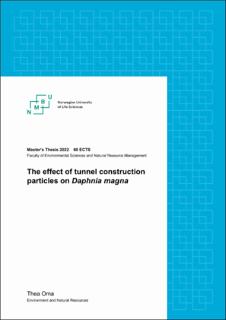| dc.description.abstract | Particles originating from drilling and blasting during tunnel construction have the potential to end up in the environment, however, there is a knowledge gap concerning the effect of these particles on aquatic biota. In this master thesis, acute toxicity tests (48h and 72h) were performed with the test species Daphnia magna to identify concentrations causing immobilization, particle uptake, and abnormal appearance. In a laboratory setup, the daphnids were exposed to starting concentration of total suspended solids (TSS) with a range between 200-3000 mg/L of tunnel particles and control. TSS and turbidity were measured to identify changes in suspended solids (SS) during test periods.
The particles concentration (EC50 values) that caused immobilizations were 761 (± 532) mg/L for the 48h test and 649 (± 82) mg/L for the 72h test. The EC90 values were 1641 (± 2361) mg/L for the 48h test and 941 (± 271) mg/L for the 72h test. For the higher estimated doses, the daphnids were more sensitive in the more extended test. The no observed effect concentration (NOEC) for the 48h and 72h tests were 492 mg/L and 562 mg/L, respectively. Exposed daphnids differed from the control in weight. Correlation tests showed a moderate negative correlation between the daphnids' weight and TSS for both 48h (R= -0.57) and 72h (R= -0.54). As the TSS increased, the daphnid's weight decreased. This can be explained by the particles being within the daphnid feeding size, which led to the daphnid ingesting the particles and getting less nutrition than the control. Therefore, the growth rate was lower. Particles in the filter apparatus of daphnids possibly leading to ingestion were also confirmed with an environmental scanning electron microscope (ESEM) of exposed daphnids. Additionally, element quantification of digested daphnids with ICP-MS showed elements like Yttrium (Y) and Thorium (Th) associated with the daphnids and positively correlated with TSS. These elements have low leaching capacity and are most likely associated with particles in or on the daphnids. The immobilization of daphnids occurred on concentrations over usually permitted values for projects. Furthermore, there were other effects like weight decrease and particles associated with the daphnids. Therefore, chronic effects would be interesting to study. | en_US |

